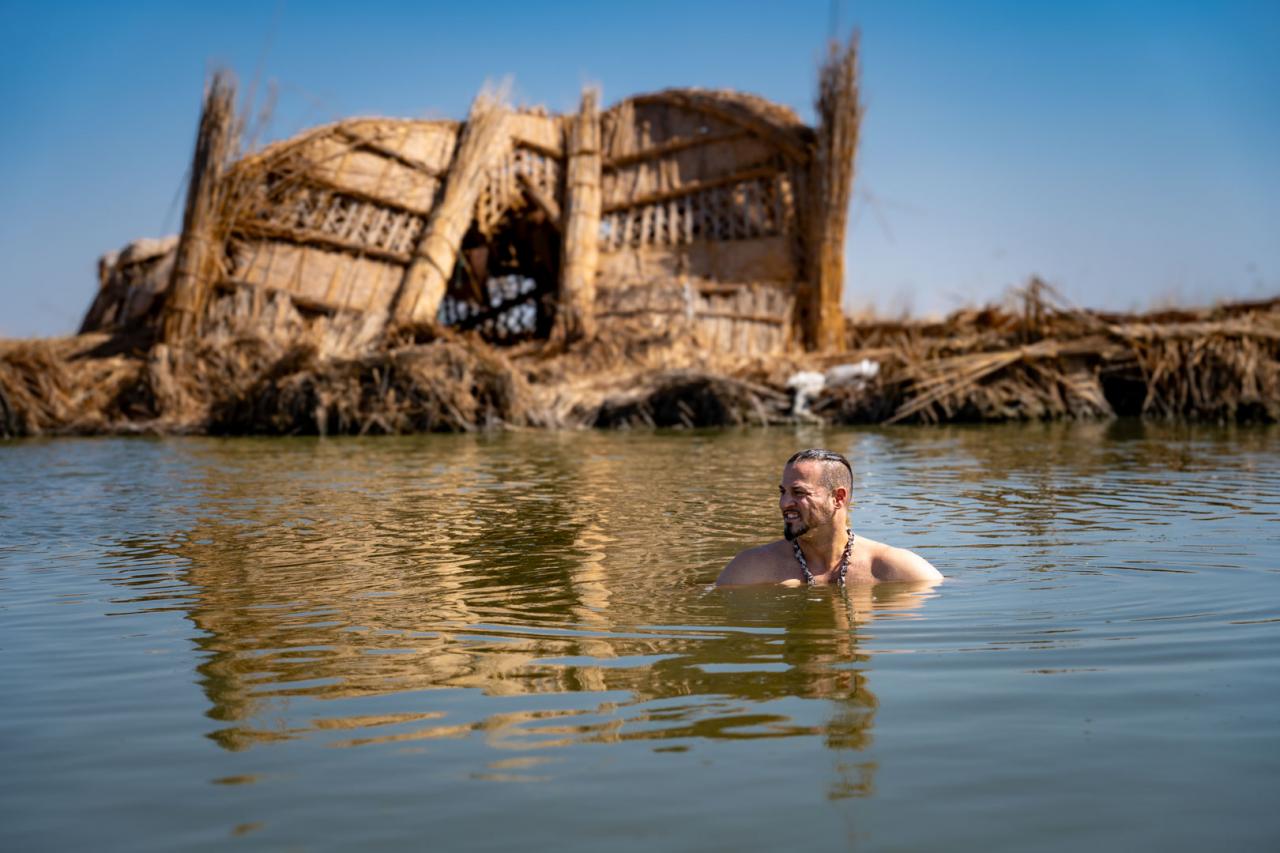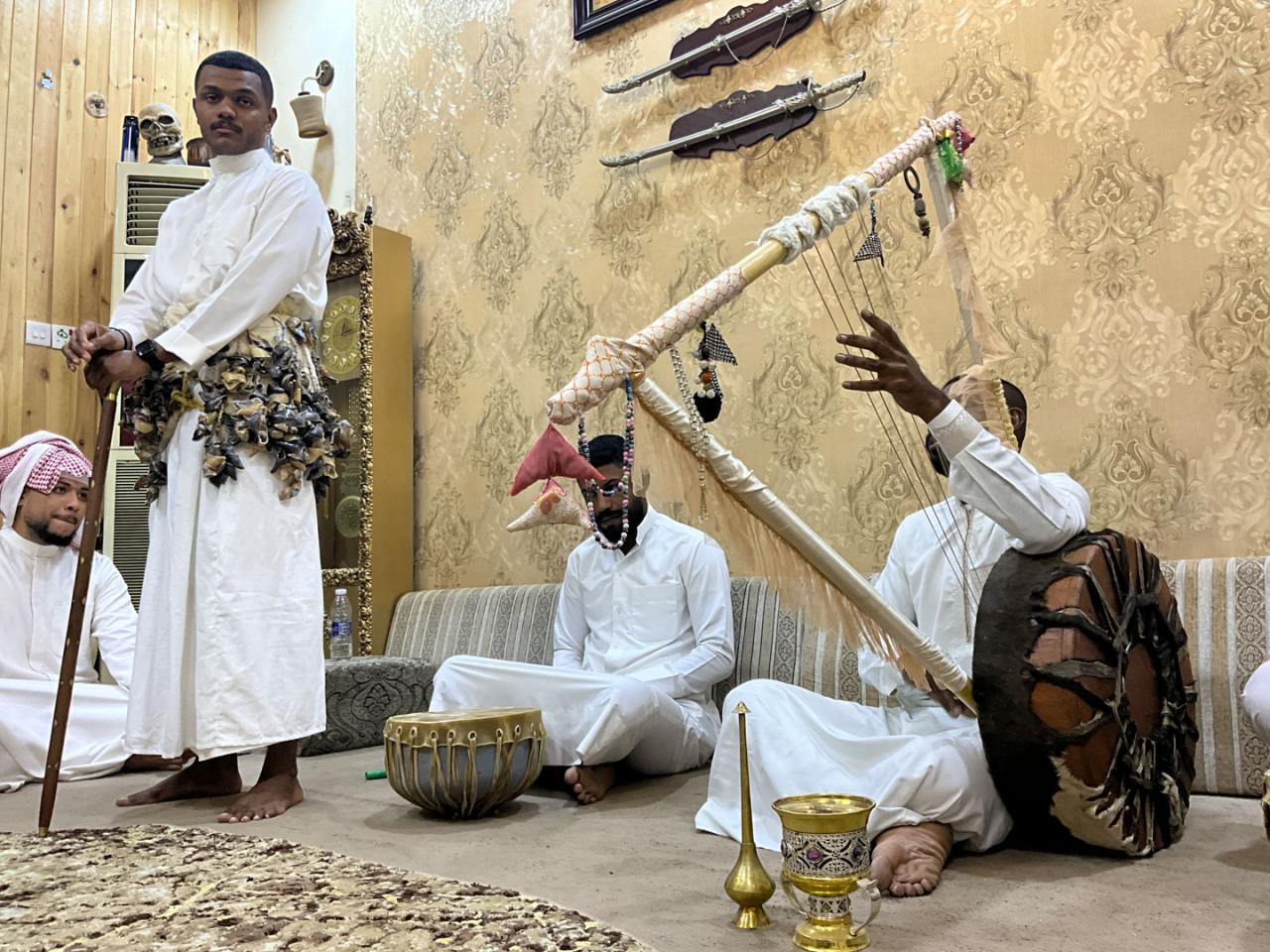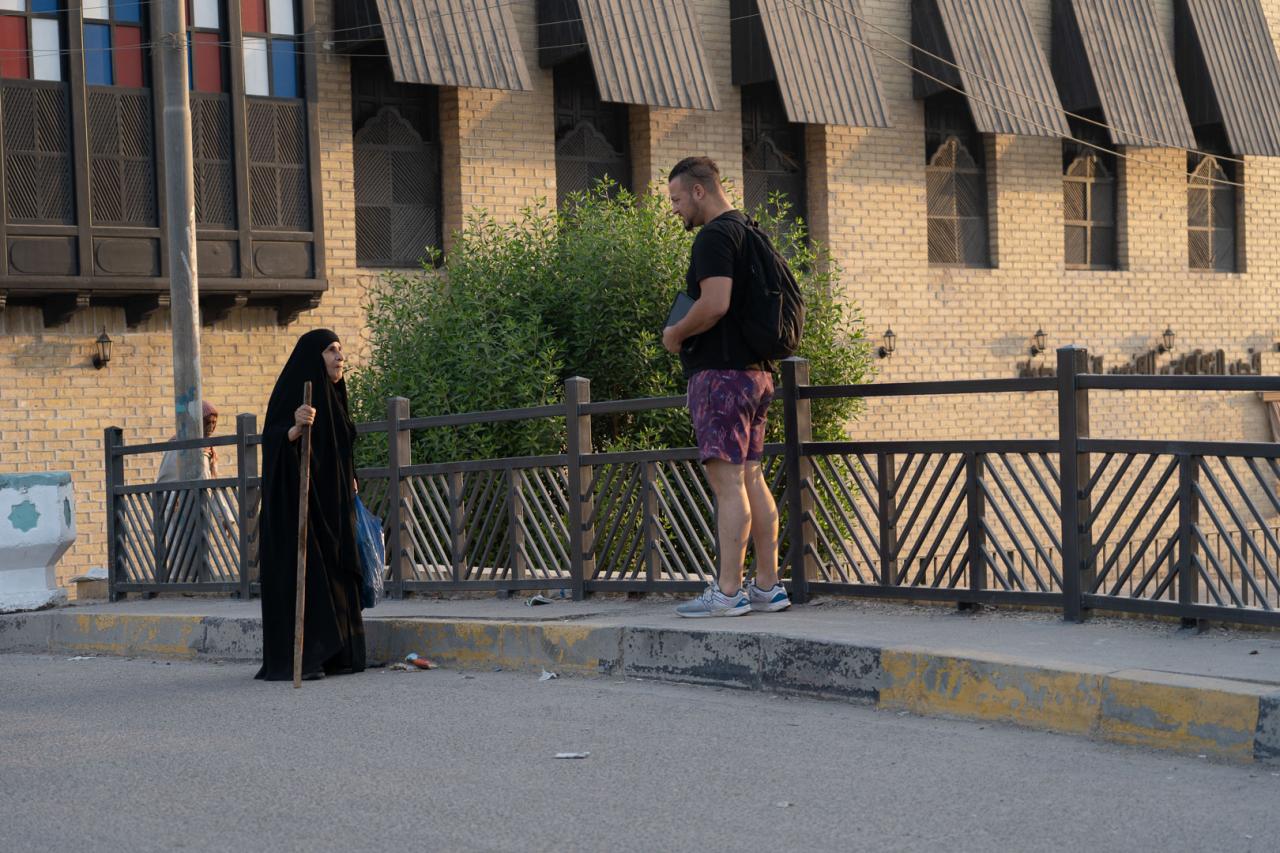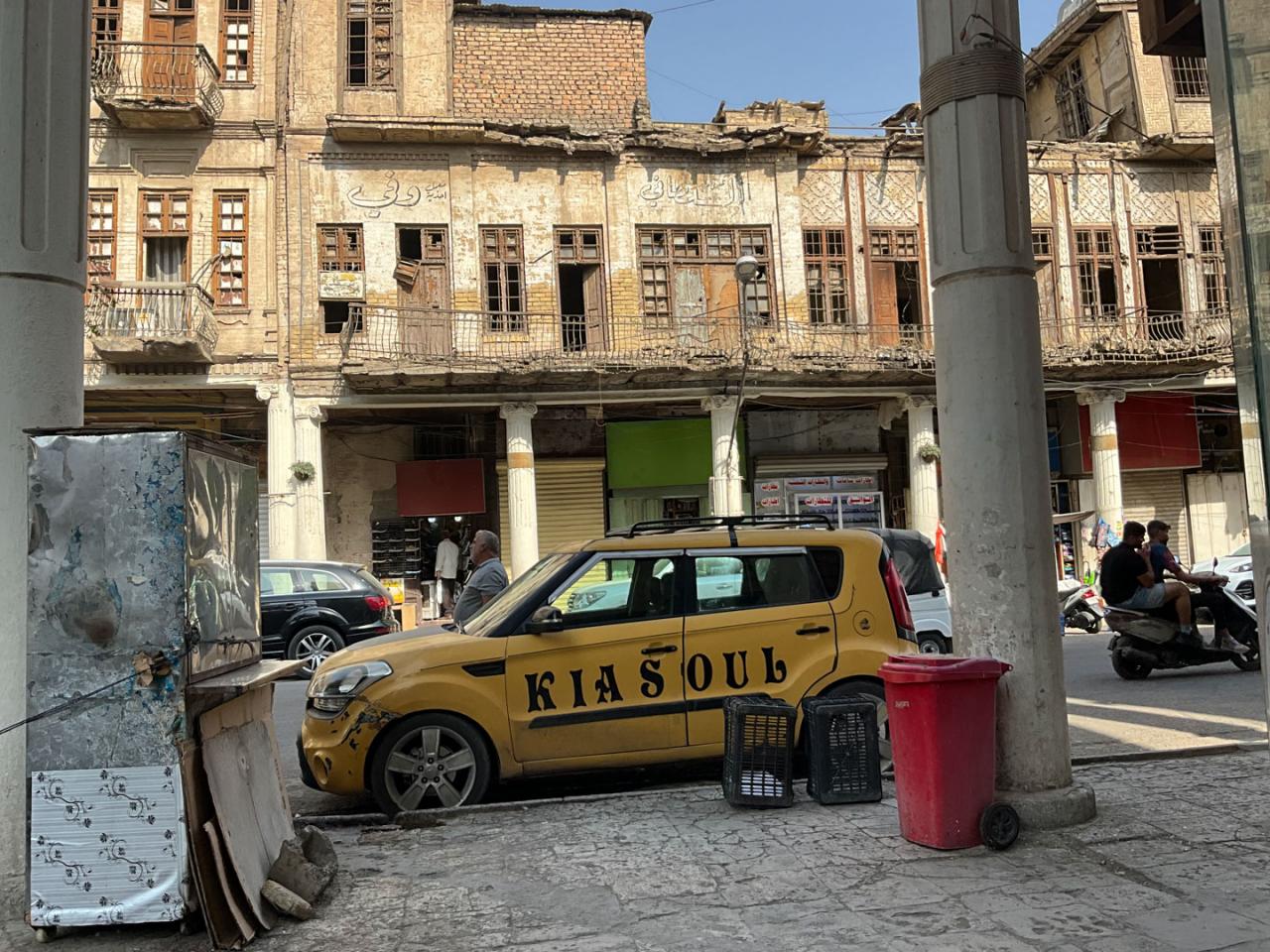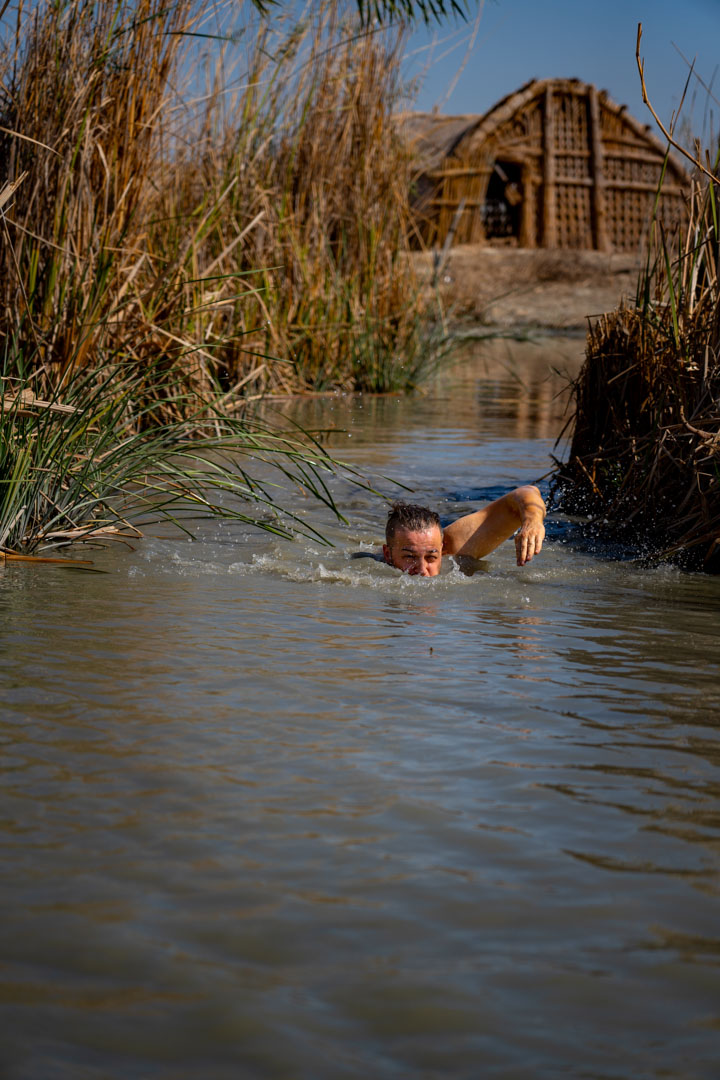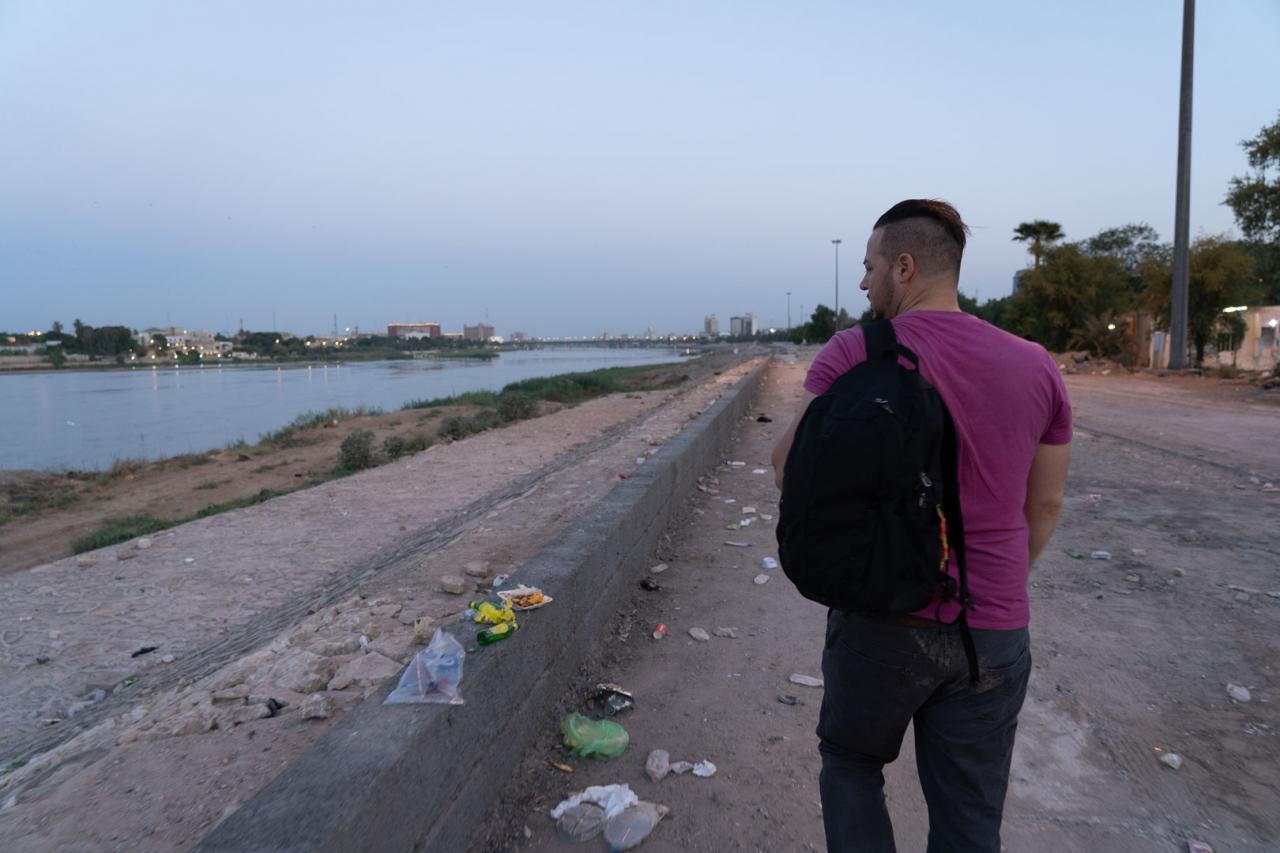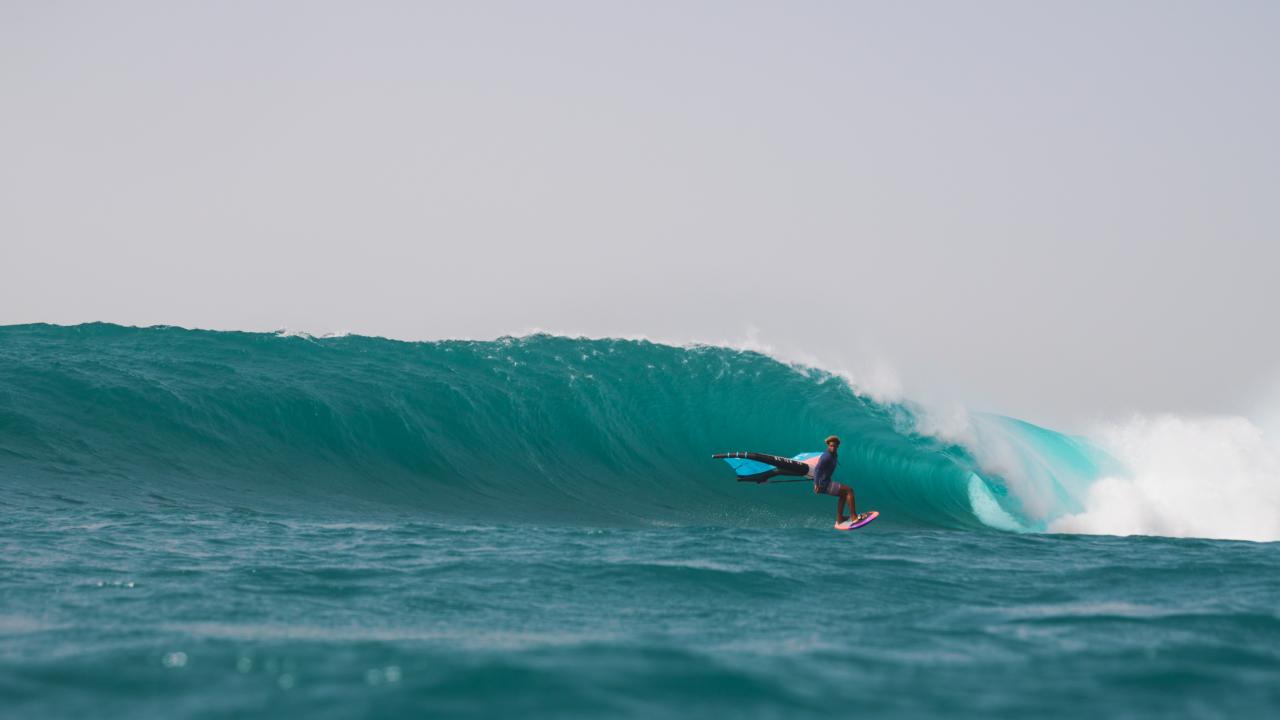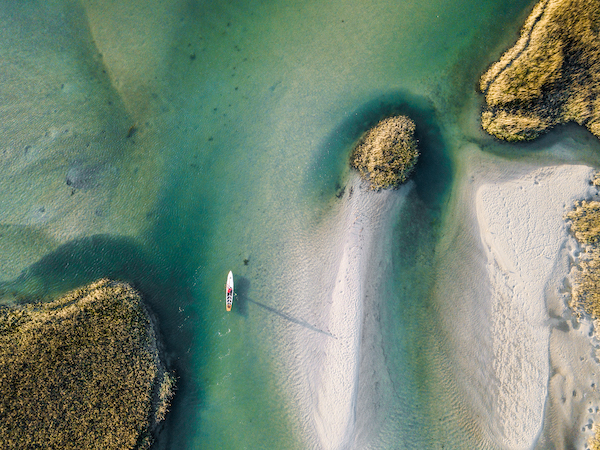BAGHDAD
In October 2023 explorer Justin Fornal led a research expedition through Iraq and Iraqi-Kurdistan to document the vanishing cultural traditions of ethno-religious minorities. The project, which is still in production, will produce a feature length documentary entitled ‘A Garden in Sinjar’.
Justin spent his free time exploring Iraq’s waterways via open water swimming.
The sun has not yet risen over Baghdad when I step out of the Ekhal Hotel. The usually bustling Watheq Square sits hauntingly silent in the pre-dawn light. My plan is to walk west through the city until I reach the famed Tigris River. If I can find a safe access point I will jump in the river and go for a swim.
At over 1,000 miles the Tigris is the second longest river in Western Asia, second only to its sister, the Euphrates. Together these two iconic waterways frame a large swath of land known historically as Mesopotamia. It was here over 10,000 years ago that rich soil and plentiful freshwater enabled ancient humans to transition from a nomadic existence of hunting and gathering to a sedentary life of farming. From this transition sprang several mighty civilizations that created history's first written languages, cities, systems of trade, and sophisticated irrigation systems. Ancient Mesopotamia (modern day Iraq) is considered by many ‘the Cradle of Civilization’. For an open water swimmer who is also a passionate student of ancient history, few rivers hold more storied allure than the mighty Tigris.
As I continue west the city starts to wake up around me. When I reach Abu Nuw’as Street I walk past a security checkpoint run by local police. A handful of officers decked out in digital blue camouflage smoke skinny cigarettes next to their armored personnel carrier (APC). I smile and wave. Behind plumes of cigarette smoke I am greeted by a choir of friendly smiles.
None of the officers question the plush white hotel towel draped over my shoulders as I disappear into a small public park towards the river. Every human interaction I have had thus far in Iraq has stood in delightful contrast with my numerous travel warnings and security briefs. I can say on the record that the people of Baghdad are among the friendliest, most easy going folks I have encountered anywhere in the world.
After regretfully startling a young couple having a romantic liaison behind the bushes, I reach a wide industrial access road composed of broken concrete. Right on the other side sits the Tigris River. I climb over a barrier and down several wide concrete steps to get a closer look. Navigating along a footpath through the tall grass I finally reach the river's edge. It is a majestic curving highway of black obsidian. I gaze upriver at the silhouetted skyline through the fading blue veil of a smoldering riverside campfire. It has taken me a lifetime to reach this moment. Now at long last it was time to swim.
As I start to undress I am startled by a seemingly lifeless body positioned on a mattress only a few feet away. The mattress rests in the mud and the body is completely covered in a shroud. I cannot even see a toe. Feeling certain that whoever is under the cloth is dead, I carefully inch closer and kneel next to the form. The sheet rises and lowers ever so slightly with human breath. I nod in relief and continue undressing as quietly as possible and stash my bag in some nearby grass. I walk back to the water's edge and remove my sandals, putting them on my hands like gloves just in case my exit requires some footwear. Gently stepping into the Cimmerian solvent, my feet quickly sink deep into the sludge. Trying not to topple over I pull them out one at a time and am delighted to find a sandy bottom a few steps ahead. Suddenly I hear a gasp behind me. I turn to see a teenage boy frantically pulling the bedsheet off his face. My floundering has interrupted his sleep. All I can do is smile and wave. His looks of fear and confusion are quickly replaced by an amused smile. I point downriver and dive in.
Within moments I am a dozen yards down river taking long smooth crawl strokes. My mind, however, is much further away as I imagine swimming among 8th century trade ships overflowing with rare spice, priceless textiles and barrels of frankincense resin, all bound for the bustling souks of ancient Baghdad. When swimming the mind travels where it pleases. As I stare down into the darkness I wonder what magnificent artifacts lie buried in the river's bottom never to be rediscovered. While modern western perceptions of Iraq (particularly Baghdad) are largely based on the years of war and conflict following the 2003 US led overthrow of Saddam Hussein’s Ba'athist regime, there is infinitely more than meets the eye.
Baghdad as a city is relatively young compared to other locations in the Mesopotamia region such as Uruk and Babylon. Construction for the city began in 762 AD, after the strategic location along the Tigris River was approved by Al-Mansur, leader of the Abbasid Caliphate. The original walled city had four gates, Kufa, Basra, Khurasan, and Syria; each gate was named for the famed location that it faced. When the library and public academy known as the House of Wisdom (Bayt al-Hikma) opened a few years later, Baghdad became the intellectual center of the then known world. Muslim scholars flooded the famous city to translate the world’s most important literature into Arabic and Persian for the new library. Its founding is considered by many historians to be the beginning of an era of advancement and tolerance, known as the Golden Age of Islam.
By the 11th century Baghdad was the largest city in the world with a population between 1 to 2 million people. On February 10, 1258, the city was captured by the Mongol leader Hülegü, (grandson of Genghis Khan). During this siege the majority of inhabitants were massacred by the Mongols and much of the original city was destroyed. Among the razed buildings was the famed House of Wisdom. Thousands of precious books were thrown into the Tigris River by the Mongols. While historians often paint an image of wholesale destruction by writing of rivers running red with blood, depictions of the ‘Siege of Baghdad’ recall the Tigris River running black with the ink of irreplaceable knowledge. Just as the opening of the House of Wisdom is considered the dawn of the Golden Age of Islam, its reckless destruction is considered the end.
As I continue my swim down the Tigris, I imagine the dark water to be infused with the ink of a million lost volumes. This knowledge, although no longer physically tangible, is still very alive and spiritually potent.
BASRA
Around 300 miles southwest of Baghdad is the city of Basra. Sometimes called the ‘Venice of Iraq’ due to its labyrinth-like network of water filled canals, Basra’s more common name is the ‘City of Shanasheel’. This nom-de-guerre refers to the over 400 traditional shanasheel style houses still standing in Basra’s old city. This classic Islamic architectural element can be recognized by its dramatic oriel windows enframed in ornate carved wood lattice work. The finest examples are adorned with kaleidoscopic stained glass window panes. In addition to adding a splash of luxurious color to a home, the glass also enabled dwellers to see outside to the street without anyone seeing back in. Many of these opulent structures in Basra date back to the 16th and 17th centuries.
For years I have admired black and white photographs depicting a famous row of shanasheel houses that line a small stretch of Basra’s al-Ashar Canal. I would often imagine what a dream it would be to take a swim down that aquatic promenade in the shadow of those regal châteaus of old.
Now as I walk through Basra on foot I begin to wonder if I will find the houses at all. Were the structures still there? If they were, would they be as illustrious as my mind had painted them? Perhaps my biggest question, would I be able to get into the water? As I turn off Al Joumhouria Street my heart suddenly swells with bliss as I see the famed row of stunning shanasheel homes. They are cast in the astounding golden splash of the rising sun. The timing is almost absurd in its aesthetic splendor.
I look down at the canal lurking at the base of a two meter vertical wall. It is immediately apparent that the picturesque canal has become a receptacle for trash and other waste. Swimming in the water in its current state would be a fairly bad idea. I also see no point of entry. Even if I jump down into the water there is a good chance I won't be able to get back out again. Probably best to just enjoy the architecture and sip a hot glass of Noomi Basra street tea.
As usual, I can’t just listen to my own advice and so begin to search for a safer place to drop in.
Due to the fact that the houses sit on the other side of the canal from the main street there is an occasional foot bridge for owners to get across. One of the bridges has a small ledge at its base a few feet above the water. To access the ledge I walk quietly onto the porch of the closest house. Not wanting to disturb the occupants at this ungodly hour, I carefully move a few potted plants off the ledge and scale down the wall onto the platform. Up close it is easy to see that the water is shallow and filled with more garbage than I thought. Not wanting to turn back and dishonor the journey I strip down to my shorts and step down into the water. The muck is warm and gluey. I do my best to get to the deepest spot possible. My right foot pushes onto a submerged plastic bag quickly penetrating it. Within the bag my foot squishes into something far more organic. A bit startled I step forward with my left foot which sinks even deeper in the muck and gets entangled in a sharp piece of metal rebar. As the canal seems to attack me from all sides I suddenly recall a conversation I had the night before with an antique ring vendor in the souk.
“Don’t ever go into the canal. That is where the jinn are living. That is where they are hiding. Cisterns, wells, latrines,sewers, canals….they are there.”
The malignant spirits known as jinn are a very real concern in certain parts of the world and the superstitions surrounding them always come up in conversation. I look up the wall of the canal and see a group of children looking down in horror at my predicament. They see a large, shirtless man slowly dissolving into the canal’s festering detritus. Perhaps their young eyes can also see the hands of 1,000 jinn reaching up through the mud, grabbing my ankles, pulling me down into the underworld.
Suddenly a roaring whir interrupts my panicked splashing and the small gallery of faces quickly disappears. As the sound gets louder and begins to echo I realize it is the call to prayer. The voice reverberates and booms down the canal hitting me like a cleansing wind. I take a moment and stop struggling. I lie on my stomach and take a few strokes forward. The water is so shallow it is hard to swim without stroking the busy bottom. I turn on my back and take a deep breath to become as buoyant as possible. Gently fluttering my hands and feet I am soon floating. With another quick full breath and a bit more fluttering I am finally moving forward, drifting beneath the magnificent shanasheel houses. I focus on my breathing and the voice of the muezzin. The jinn have gone silent and burrowed back into the mud. I find buoyancy and peace in the shallow cloudy water.
I gaze up at one of the houses as I drift under it, admiring the latticed spires on the oriel windows. I wonder who is there. Perhaps there is a woman with long rich hair watching the sunrise; watching the sunrise and playing a tanbūra.
AT LAST EDEN
Since Mesopotamia is considered history’s ‘Cradle of Civilization’ it makes sense that to many it is the spiritual one as well. This is why a diverse number of belief systems place Iraq as the geographical location for the Garden of Eden (or its equivalent). The Yazidi people place Eden on the grounds of their most holy site, Lalish, while others believe it was where the Tigris and Euphrates Rivers meet. Another potential location for the Garden of Eden is the Mesopotamian Marshes, a unique wetland environment in Southern Iraq that is home to cultural elements that have changed very little since the area became populated many thousands of years ago.
My guide Abu Haider sings loudly as he pilots his mashoof (a long slender canoe) expertly through the curving passages of the marshes. Abu is a fisherman and elder within the Marsh Arbab community, also known as the Maʻdān. He is a proud descendant of the ancient Sumerian people and loves to share the unique marsh lifestyle with outsiders such as myself. Dragging my hand outside the mashoof the water feels electric against my finger tips. A few water buffalo cool off in the slough, with little more than their horns and eyes breaking the surface.
Abu stops the craft, points at me and then points forward. I take this as my cue to swim.
Within moments I am standing in chest deep water putting on my goggles. While I enjoyed exploring the urban waters of Baghdad and Basra, this was different. This was a truly wild swim. I could swim as far as I wanted and the best part was I had a guide, a boat, and even an invitation to lunch.
Propelling swiftly through the grass - framed channels, I get glimpses of traditional reed houses each time I take a breath. The dwellings, created completely from wild reeds harvested in the marshes, are constructed by building parabolic arches for the infrastructure and woven mats to cover the exterior. Large dwellings used for social gatherings are called mudhifs while smaller ones used by a single family are called rabas.
Historians believe the Marsh Arbas have been using the same design and process for over 5,000 years. It is only within the last century that the traditional lifestyle has been threatened. Since the 1950s several large scale projects have been launched to drain the marshes. The most harmful was carried out by Saddam Hussein's Sunni-led Ba'athist regime to oust Shi’a insurrectionists who were using the marshes as a base of operations. It was estimated in the year 2000 by the UN’s Environment Programme that 90% of the marshlands were completely gone. In addition to having a catastrophic effect on plant and animal life in the region, repeated draining and destruction of the marshes forced a large portion of the indigenous community to flee their ancestral homes and relocate to urban centers.
While there have been many commendable civic projects to resurrect the marshes in recent years, they have been largely undermined by drought, rising temperature levels due to climate change, and by the damming of the Tigris and Euphrates Rivers in both Turkey and Syria. History’s most iconic wetland region is heading directly towards desertification. Less liquid in the marsh equates to more concentrated salinity in what water does remain. In many situations this means death for both plants and livestock. While in the 1990s there were still over 12,000 miles of water-logged terrain, today there are less than 3,000.
As I continue swimming through what is left of the great herbaceous inferno, I notice the occasional strip of burlap sack tied to the swamp grass. Abu lets me know that they are directional markers for navigating the seemingly endless maze-like surroundings. I realize that to my untrained eye the majority of the marshlands look pretty much the same. Aside from the occasional reed house or corral of water buffalo, there are very few landmarks to keep one from getting lost. Where I see a vast indiscernible alluvial plane, Abu sees a storied terrain that he knows as well as his own face.
After swimming around a curving bend I see a pillar of smoke ahead. I stop swimming to look up at Abu piloting the boat still lost in song. He smiles, motions to the shore, and continues to sing. As we get closer I see a beautiful mudhif house with a crackling campfire outside. Abu’s nephew is tending to some roasting fish and a collection of steaming kettles. Pushing through the reeds I climb ashore and feel the bright Iraqi sun immediately warming my wet skin. I see two massive butterflied carps sizzling over the flames, each in its own cast iron grill basket. He is preparing masgouf, an ancient Mesopotamian fish recipe that continues to serve as the national symbol of Iraqi hospitality.
As I enter Abu’s home I see nothing within a 360 degree view that is not as it could have been 5,000 years ago.
Most cultures tend to be a product of their surrounding environment; so sadly many of the traditional ways of the Marsh Arabs have been lost as communities continue to flee ancestral lands. Abu explains the twilight of his culture with bittersweet eloquence.
“This culture evolved from my ancestors using the marshes to survive. When we leave this land the culture cannot leave with us. They are one and the same.”

